In 2012, when I visited Tuscany for the first time, I did things that most first-timers do – tick marking all the attractions, travelling everywhere by car, shopping at Florence’s Via de’ Tornabuoni boutiques, eating four-course Italian meals with a bottle of Brunello di Montalcino, climbing the Leaning Tower of Pisa, and spending hundreds of euros staying in the heart of Florence. I did all this, and it was worth it. It really was.

However, when I returned to Italy after six years, my travel goals had changed. I no more longed to see everything in three days. Sure, I could zip from one place to another. But why let FOMO dictate my travels when there’s a better choice available? The Tuscan countryside is like the Chianti produced there – meant to be savoured rather than gulped. While there is no dearth of interesting ways to explore Tuscany, I decide to walk an ancient pilgrimage route – the Via Francigena Toscana (pronounced Fran-Chee-ge-na). The 1300-miles long route ran in the Middle Ages from Canterbury through France, Switzerland and Italy before reaching the Eternal City, Rome.

Almost forgotten for centuries, the route has been given a new lease of life in recent decades by the fervent efforts of locals and the government. In 2009, the Italian government decided to revive the whole Italian leg of the route based on the journal written by Sigeric, archbishop of Canterbury, on his way back from visiting the Pope in AD 990. However, the revival process was a bumpy ride. Roadblocks existed in the landscape and mindscape alike.

Alberto Conte, Founder of
Ten years ago when I started walking Via Francigena with a group of
travellers , a BMW stopped and said, “we don’t want you here.
With a big smile on his face and a twinkle in his eyes, he continues,
But now the attitude of the locals has changed completely. They have seen the cultural and economic benefits of having modern pilgrims in areas that never saw tourists. Now they even offer free water, coffee
and food to the pilgrims.
The Via Francigena Toscana trail
Day1: Arrive in Montecatini from Florence
One day before my trail begins, I arrive in Montecatini Terme, an 18th century Spa town famous for the healing mineral water. Sloways, the local company managing my travel, preps me well in advance.
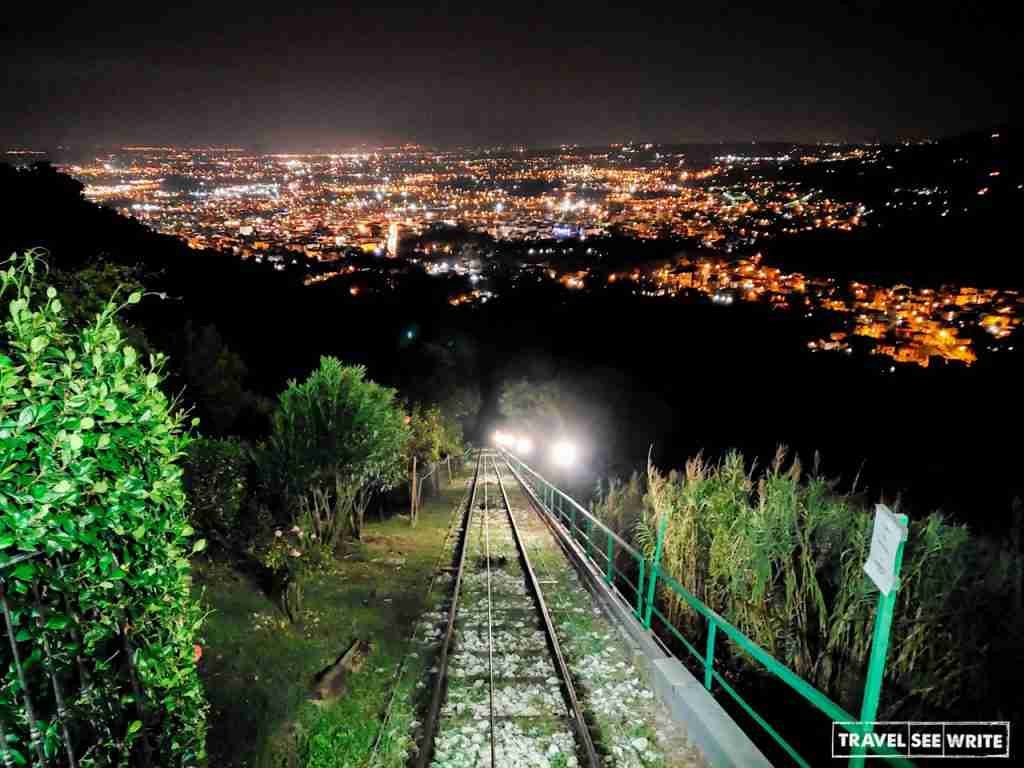
As the evening befalls, I reach the old funicular tram that goes to Montecatini Alto, an ancient hamlet where our group dinner is planned. During the ice-breaker session, I ask Tullia Caballero, the Director of
The Via Francigena is different from other long-distance trails because it has been in use for nearly 2000 years. This succession of
civilisations , history, architecture, culture, traditions, food and wine, and the constantly changing landscape is a treasure trove for all your seven senses.
Recalling the heydays of the route, Tullia shares how this route was once used by Europe’s best and the greatest minds. Thriving commerce transformed the hamlets into beautiful and powerful cities, many of which are now UNESCO world heritage sites. You’ll see the beauty of this pilgrimage yourself in the next few days.
Day 2: From San Miniato to Gambassi Terme – 20.5km

The next day after driving for two hours, a group of ten people from all around the world – Norway, Sweden, Canada, USA, Australia, Brazil, Japan, India, and Jordan along with three local experts start walking the trail near the hilltop town of San Miniato. I see a tiny image of a pilgrim welcoming us, which later appeared almost on every patch of the trek – whether, on a lamppost, small sign or spray-painted on the pavement – to guide the modern pilgrims like me.
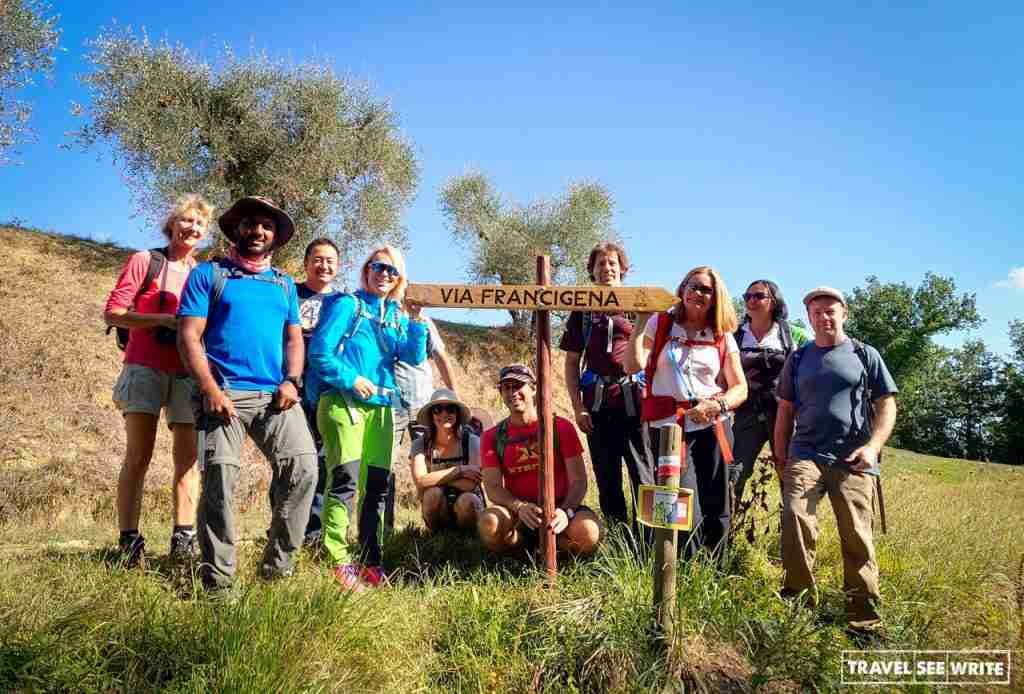
Erica Masini, our environmental guide, talks

As I begin my pilgrimage through a classic Tuscan landscape of quilted green hillocks, freshly harvested golden wheat fields and olive groves, I try to take in the beauty around. Despite walking with a group of people the ringing in my ears stopped – and I was stunned by the silence. The music of no sound, after the clamour of tourist-rundown cities, was so pleasant it was almost overwhelming. Then like an orchestra tuning before a concert, isolated notes started reaching my ear, one by one: the harmonic melody of far off birds, a tractor mowing a field in a distance, a vagabond breeze rustling the olive trees. I am lost in a world where everything is beautiful.
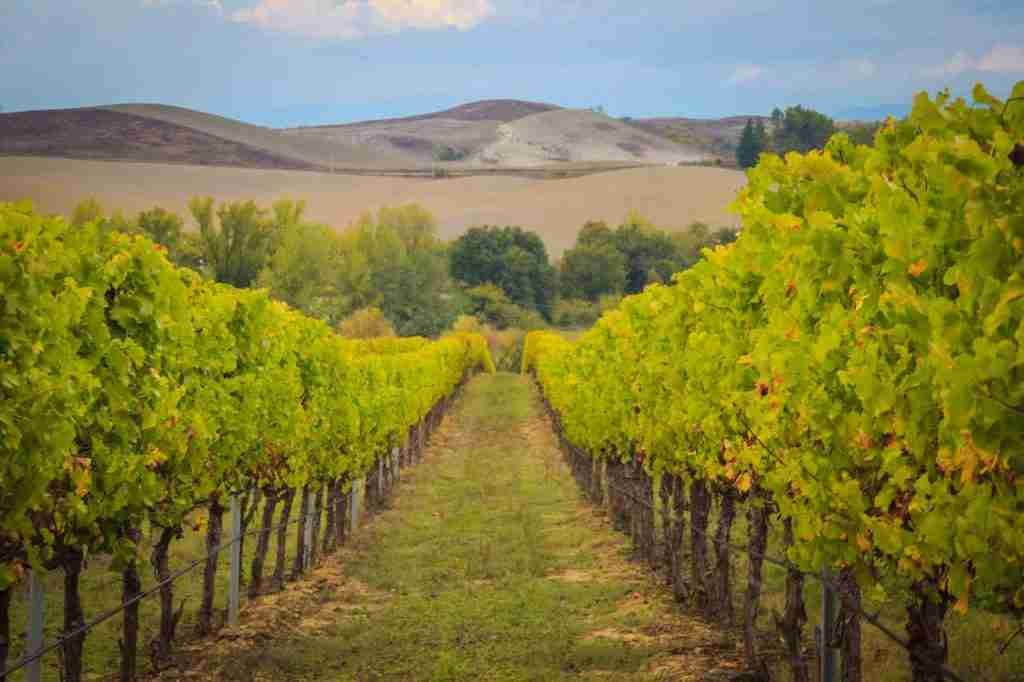
After three hours of walking in 24-degree Celsius temperature on a snaky path stitched with the folds of hills and skirting vineyards, we reach the cool surroundings of a recently restored 1100-year-old Romanesque Church – Pieve a Chianni. It was here, where Archbishop Sigeric stopped on his way from Rome to Canterbury. While we take a tour of the church, Ernesto, our Italian host and trek guide, prepares our picnic lunch of bread, salads, fruit, crackers, meats, cheeses, olives, and wine.

After a hearty Italian meal, we continue our journey to Gambassi Terme.
We spend the night at Ostello Sigerico, a friendly pilgrims’ hostel from the 13th century where we are treated to a delicious homemade Italian meal by our local host Franco and his family.

Day3: Gambassi to San Gimignano – 17.6km
The next day our eyes and limbs are all set to reach San Gimignano, arguably the most beautiful hill town in Tuscany and a UNESCO World Heritage site worthy of the nickname ‘Medieval Manhattan’ for the 14 towers that adorn its skyline.

Though the route was shorter than the earlier day but more diverse in appeal – we pass through freshly overturned fields with earthy fragrance, golden-yellowish vineyards where most grapes have been harvested, dry sunflower fields, long avenues of cypresses, rolling hills, lush green forests which have started flaunting fall colours. In mid-afternoon, a view of San Gimignano’s famous spires peeks through the trees, and soon we join a road filled with cyclists in bright outfits.
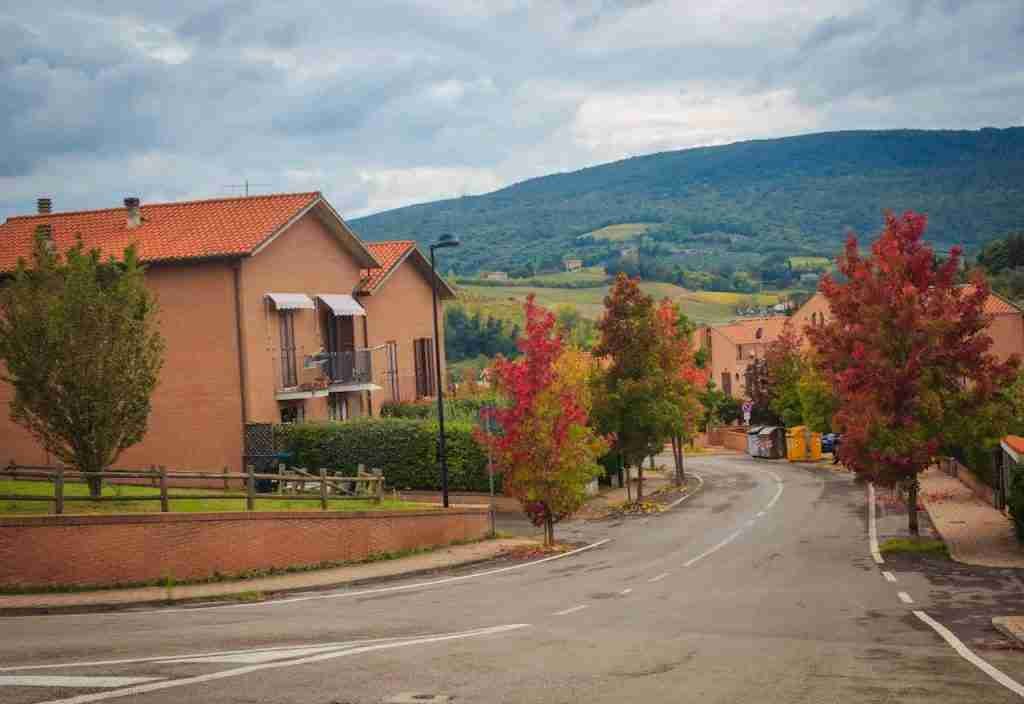
After settling down in our 3-star centrally-located Hotel La Cisterna, we set out to explore the UNESCO city of 100 towers. Our guided tour of the town starts with climbing up the tallest tower of the “Medieval Manhattan” – the Torre Grossa. I travel back in time looking at the panoramic view of the sky-piercing stone towers, and narrow cobbled-stone streets surrounded by an expansive countryside filled with vineyards. Suddenly I am jolted back into reality when Erica narrates the history of the town,
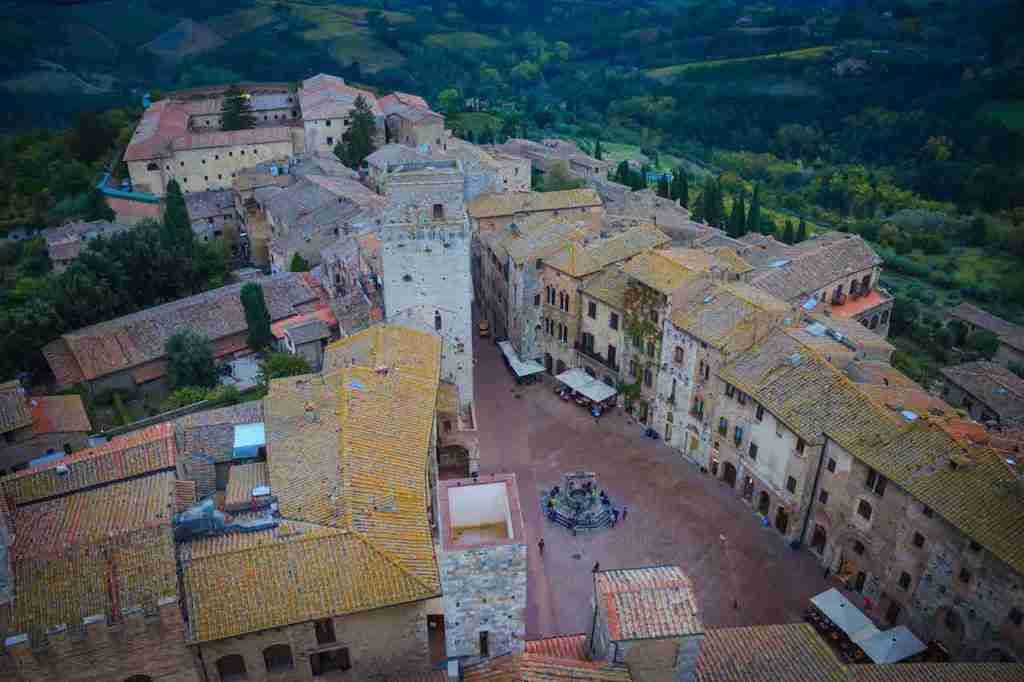
The patrician families who controlled the town built around 72 tower-houses as symbols of their wealth and power. Although only 14 have survived, San Gimignano still has that feudal atmospheric vibe.
Listening to the power struggles of the middle ages, we walk down the stairs to see some of the most beautiful medieval palaces in Tuscany, like Palazzo del Popolo and Palazzo del Podestà.
The star highlight of the day was a wine tasting at the Museo del vino Vernaccia di San Gimignano. As the Tuscan sun hugged the whole valley into its golden dust, an expert sommelier took us on a sensual journey of Vernaccia, a fruity local dry white wine produced only in Tuscany since the 13th century. We wrap up the day by enjoying a typical homemade Tuscan dinner at Osteria delle Catene.
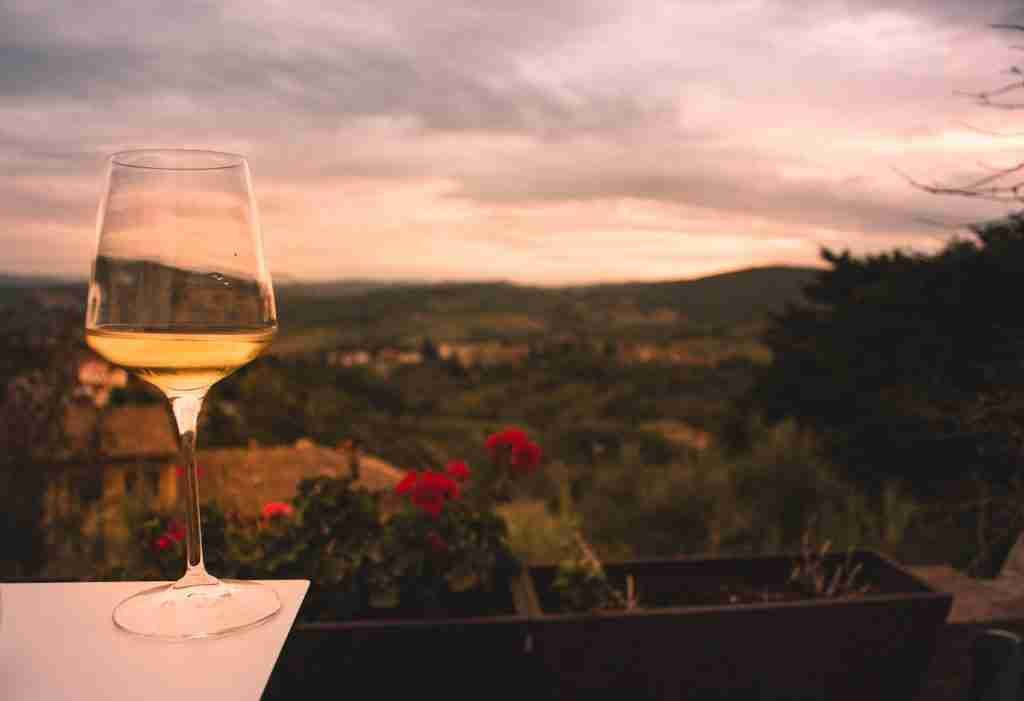
San Gaminino is one of my favourite places in Tuscany partly because it is so emphatically not a ten-minute tourist stop. Every street, every tower, every art piece, every glass of wine compels you to spend some more time here.
Day 4: From San Gimignano to Abbadia Isola – 25.4km
With a reluctant heart, I leave San Gimignano to pay a short visit to a completely off-the-beaten-track Agriturismo farmhouse, who’s owners are keepers of the keys to an ancient Etruscan altar normally closed to the public. Torraccia di Chiusi is a 1,030 years old refurbished cosy country house with seven guest rooms, its own restaurant, panoramic pool and picturesque surroundings hard to beat.
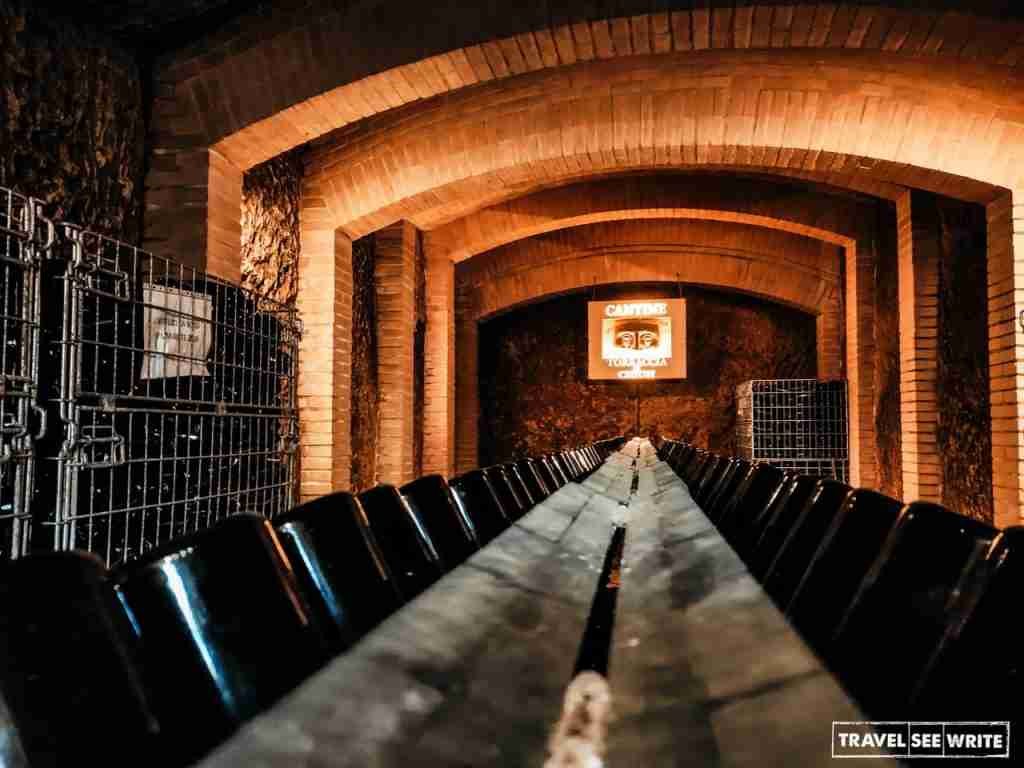
And, it’s not just the surroundings, but the owner Donatella, and her staff that makes you feel so welcomed. With glittering eyes, filled with childlike excitement, she passionately shows us around the house, its grounds and the
On the property, we’ve found Roman coins,
jewellery , small marble markers with Roman etchings, and other Etruscan structures.
Before bidding goodbye, we are treated with coffee and homemade snacks.
From here we trudge through vineyard-covered rolling hills, cross the Elsa river valley, jump into the freshwater stream, and rest for a while in historic but abandoned villages before reaching Abbadia Isola, a 1000-year-old abbey. This large Romanesque abbey was covered with marshlands until the 11th century and then Benedictine monks took charge and built an important monastery and church, which is still recognised as a masterpiece of Romanesque art. Hence the town got its name Abbadia Isola which translates to ‘abbey island’. It was an important town in medieval times due to its strategic position right on the border of Florence and Siena territories. Like Archbishop Sigeric, we too take solace here, rejuvenating our body and soul with a hearty meal and a comfy bed in Ostello Contessa Ava.

Day 5: From Abbadia Isola to Siena – 18.6km
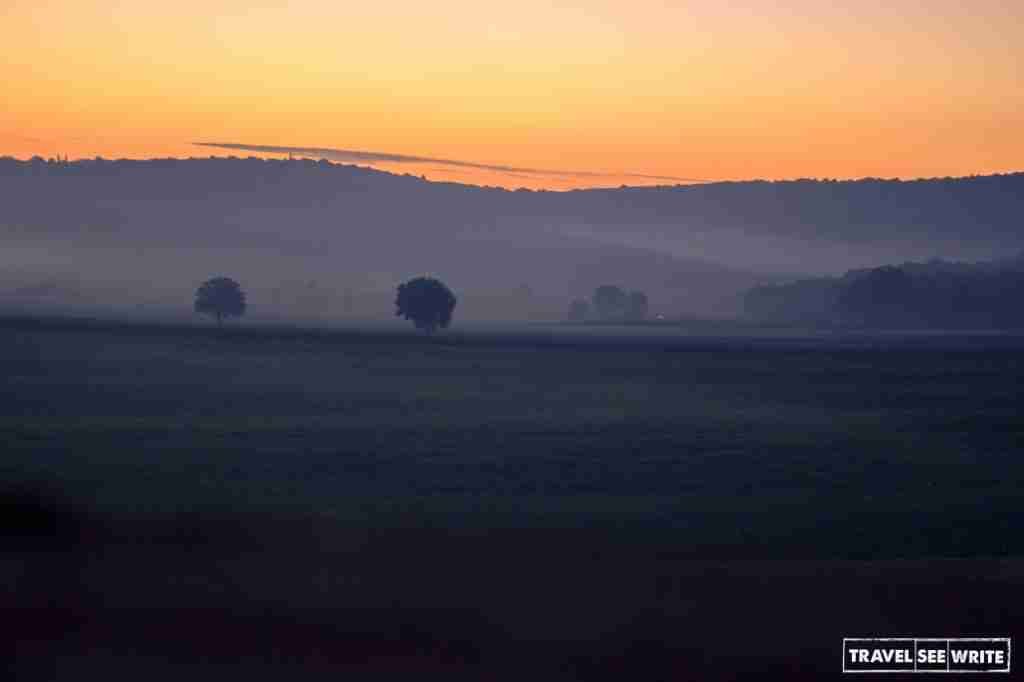
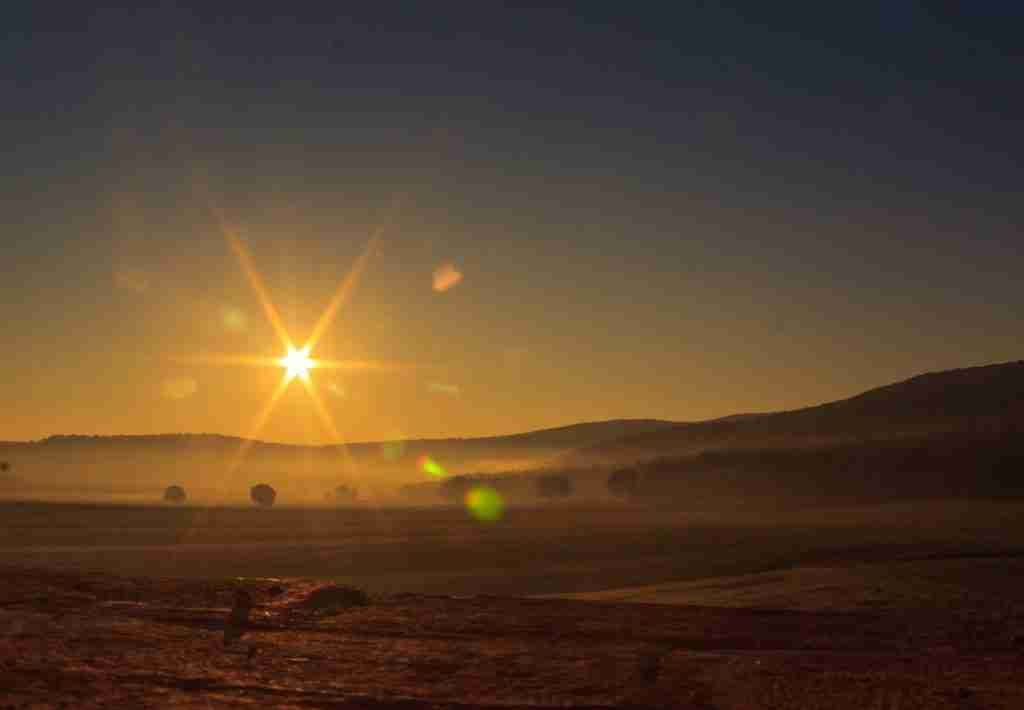
From Abbadia Isola we walk to the perfectly preserved tiny medieval walled town of Monteriggioni. Despite power changing hands several times, Monteriggioni hasn’t lost a bit of its Medieval character. As we reach the castle, the Mayor of the town greets us and gives a peek into the history of the place,
The castle of Monteriggioni has never been conquered. And, that’s why nothing has changed here – from compactly woven cobbled streets to its city walls. The castle was once surrounded by coal,
that would be lit in case of attack.
We spend a bit of time in the castle gazing at the Armoury Museum and treating ourselves to gelatos and cakes before heading onwards to Siena

We walk through a landscape that changes outfit every five kilometres – from lush green forest to brown hillocks. The beauty of this landscape is enhanced by scattered castles, fortified farms and forests that witnessed many legendary battles between Florence and Siena.

For lunch, we stop at the ‘Punto Sosta’ (means stopping point), a wooden picnic shelter beside a ring of tree-stump seats in the front yard of a house halfway between Monteriggioni and Siena. Soon we were welcomed by one of the most generous persons we met on the pilgrimage – Marcello Pagnini, the house owner.

Starting in 2012, Marcello has dedicated his life to serving the Via Francigena pilgrims. No one goes hungry from his humble abode. Every single day he wakes up early in the morning to bake his bread, curate meats, makes wine, cleans the place, does the dishes, buys new books for visitors and entertains them with his stories. He works on a donation basis and considers pilgrims as his source of positive energy. He recently lost his wife, which made him a little lonely and sad but that didn’t stop him from serving the pilgrims. For the first time in Via Francigena Toscana, I get teary-eyed when Marcello gives me a hug. My heart swells with the generosity shown by a stranger. It is people like him that make Via Francigena a true pilgrimage.


We walk for a while amidst a forest of oak trees before reaching the Hermitage of San Leonardo al Lago, which has treasures from the 14th and 15th centuries – beautiful frescoes – that come alive when the hermitage’s custodian narrates the bygone era tales.
We then get transferred to jaw-dropping Siena, one of the loveliest and busiest towns in Tuscany. In the heart of Siena lies Piazza del Campo, famous for the world-renowned “Palio” (a historic horse race) held twice in the square every Summer. I walk around the cobbled streets gazing at the beauty of the Gothic architecture of the middle ages.
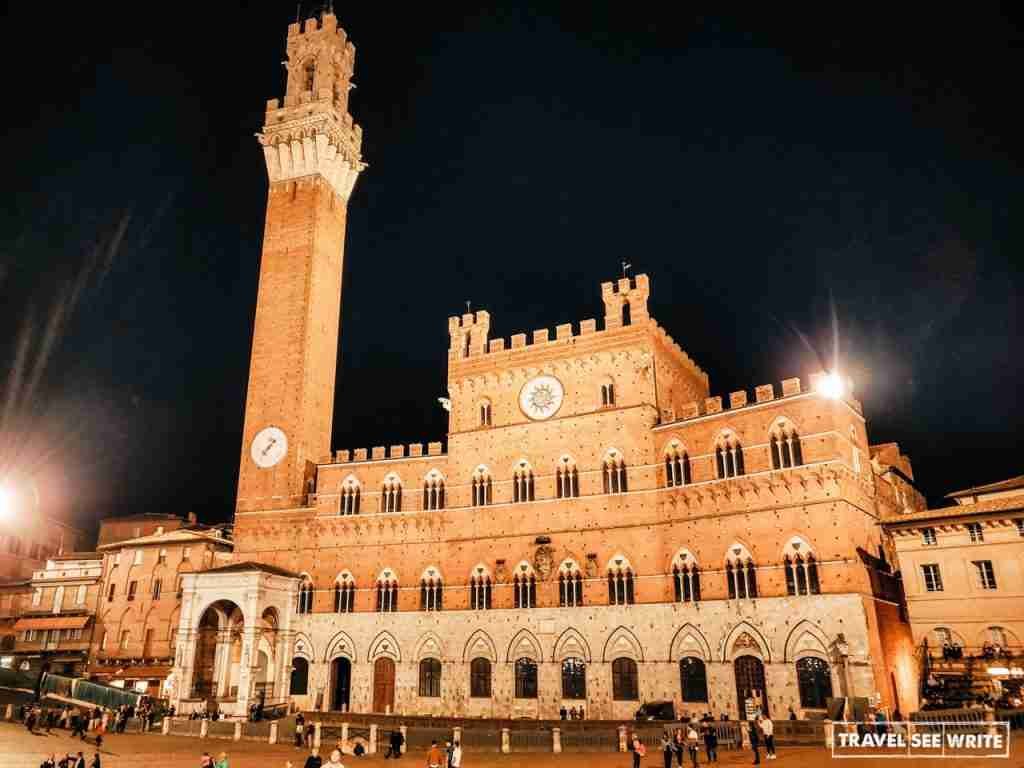
The day ended with us relishing one of the best pizzas in Siena at Il Pomodorino while overlooking the Duomo of Siena.
Day 6: From Lucignano to Buonconvento – 13km
The last day of the trek is fairly easy. From south of Sienna, we take a shuttle to Lucignano and from there we walk on the soft ochre-coloured Sienese clay hills topped with a line of cypresses leading to isolated farms. After walking for a few hours, we reach our lunch spot – Fattoria Pieve a Salti near Buonconvento, a 700-hectare Agritourism organic farm, from where Barilla, Ferraro and others get the grain for their different kinds of pasta and cereals.


A scrumptious lunch is further accompanied by a great Tuscany wine tasting at Italy’s first all-woman run vineyard – Donatella Cinelli Colombini. We taste various wines of different ages with different pairings, the most thrilling being tasting wine with music. That is a first for me.

The last leg of our trip is on a bus that brings us back to Montecatini Terme where our trip ends.
The Inner Journey
Before I embarked on the Via Francigena pilgrimage I had no idea what was in store. Frankly, I was more worried about the physical aspect of the journey than the emotional journey. However, once I started walking I realised this trail is no ordinary trail, it changes you from deep within. There are geographical hubs and there are spiritual hubs, and then there are hubs in a completely different sense – places that ground you, that bring you back in touch and balanced with something deeply important inside you.

It was here I met and bonded with people I could have never crossed paths with in ordinary life – who don’t just talk about bringing a change in the world – they walk the talk. Through the rolling hills and heritage sites, the wines and the bites, the sore thighs and the soaking rain, we bonded as a group. Life stories and future plans were discussed over long dinners filled with laughter and unlimited Tuscany wine.

Although, I did meet a lot of interesting people, enjoyed gastronomic delights, saw many exciting places nothing extraordinary happened during the entire trail, and that was precisely the point: the trail gave me a great chance to connect with the heart and soul of Tuscany, and in doing so, offered enlightening insights into the simple pleasures of Tuscan life.

I might not be a classic pilgrim but you don’t even have to be religious to experience the joy of walking the Via Francigena Toscana.
So, when are you walking the 1200-year old pilgrim path to Rome?
Via Francigena Tuscany Travel Tips
How to get to Tuscany?
Fly from any Indian metro city to Florence or Pisa and then take public transport to reach San Miniato.
When is the best time?
May-June and September.
Where to stay in Tuscany
You can stay at pilgrim hostels, monasteries or 3-star hotels on the trail. I stayed at La Cisterna in San Gimignano, Pilgrim Hostel Sigerico in Gambassi, Ostello Contessa Ava in Abida Isola and Hotel Italia in Siena
How to do it
A self-guided tour for three days starts at €140pps and guided group tour for five days start at €570pps with Sloways (https://www.sloways.eu). Prices exclude flights.
What to pack for Tuscany travel
Well-fitted hiking shoes, comfortable clothing and a hat are vital things to carry. Keep your daypack light with a reusable water bottle, snacks, sunscreen and camera.
For more information on the Via Francigena see viefrancigene.org
PS: I am sure many of you have followed by
- 4 months Solo Budget Travel in Europe
- 15 Best European Christmas Destinations
- Complete Travel Guide: From Zagreb to Plitvice Lakes, Croatia
- Plitvice Lakes: why this is a must visit Croatia National Park
- Czech out: Fun things to do in Prague
- A lost medieval town of Slovakia that changed the world
- Unheard of Easter Traditions of Romania and Slovakia
- 10 reasons to look beyond Paris and visit Northern France
- Beyond Paris: Sights and bites of Northern France cities
Published on
An edited version of this story was published in the following publications:
- Firstpost: ViaFrancigena – Walking the 1200-year old pilgrim path in Tuscany
- Travel and Leisure: Discover Via Francigena In Rome: The Forgotten Pilgrim Path
- Hindu Business Line: Via Francigena Trail: A pilgrimage in Tuscany
- Sakal Times: The Walk
- All about world heritage sites: ViaFrancigena – Walking the 1200-year old pilgrim path in Tuscany
- Deccan Herald
- BBC travel Journeys
Inspired? Pin these to your Pinterest boards
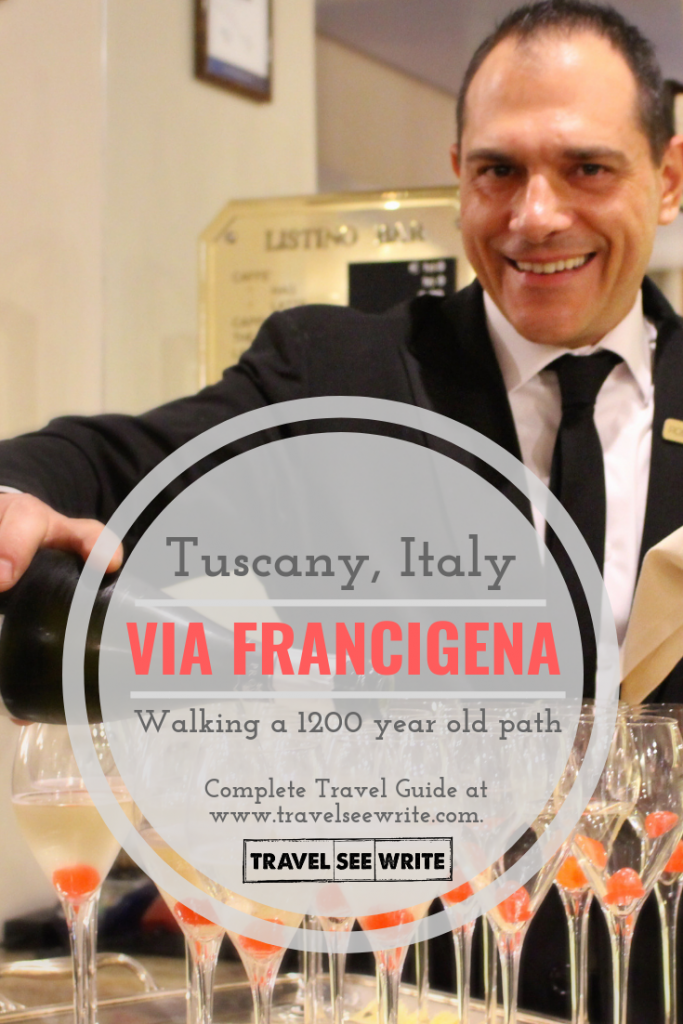

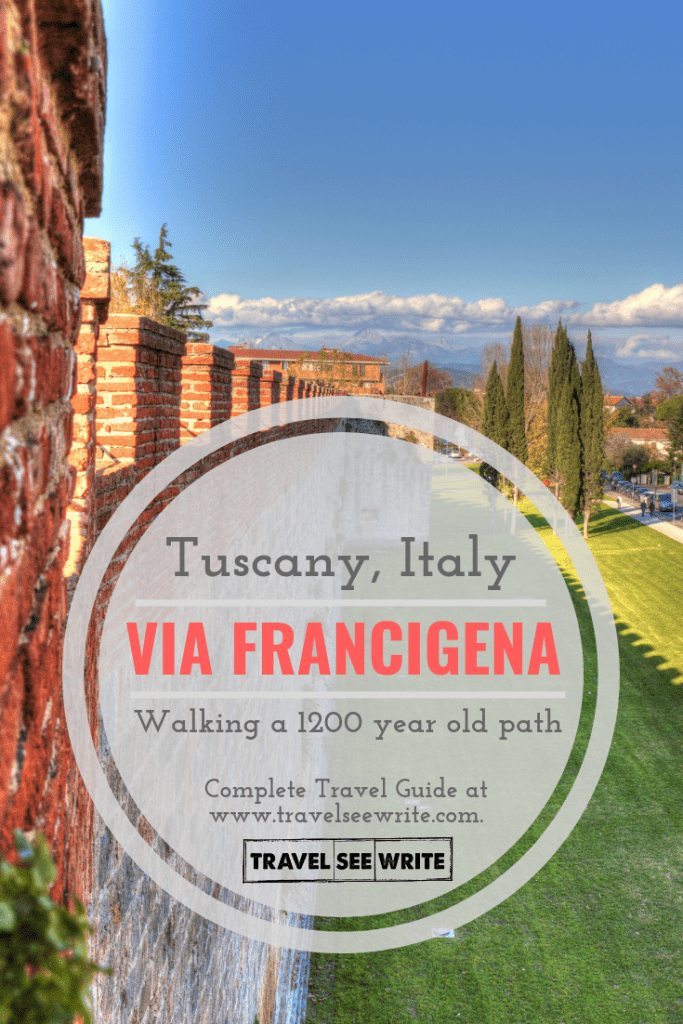

Disclaimer
I was invited as a hosted media to attend the Adventure Travel Summit Tuscany 2018 by the Toscana Promozione. This pre-adventure trip was part of my vist. All the views expressed above are based on my personal experiences in the country during my visit. Images used are shot by me. Please do not copy anything without written permission.

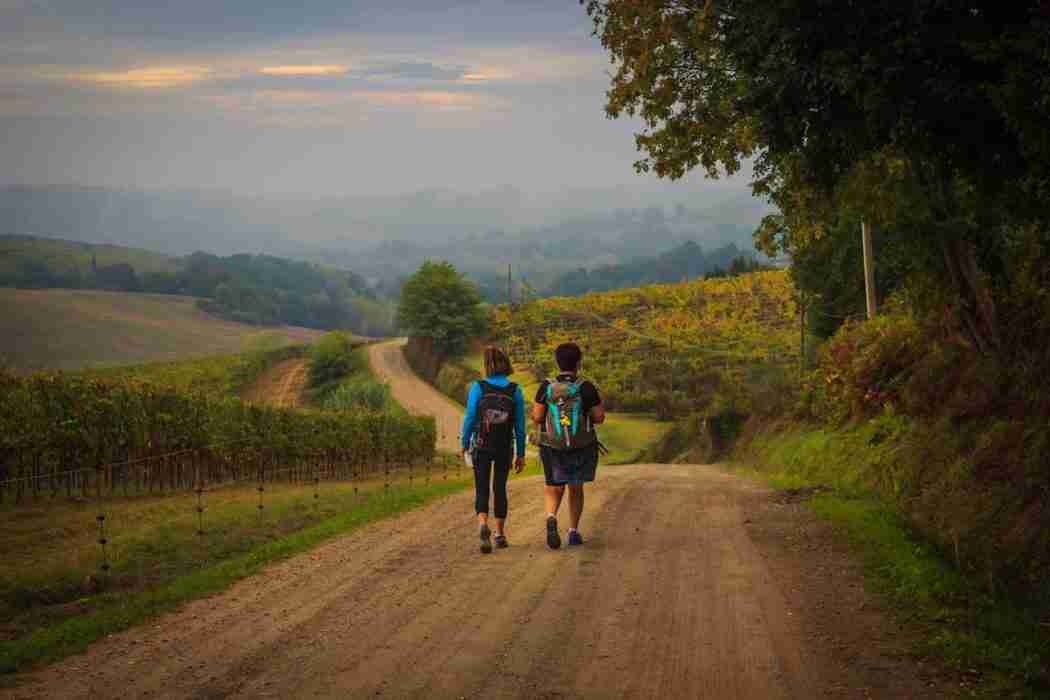
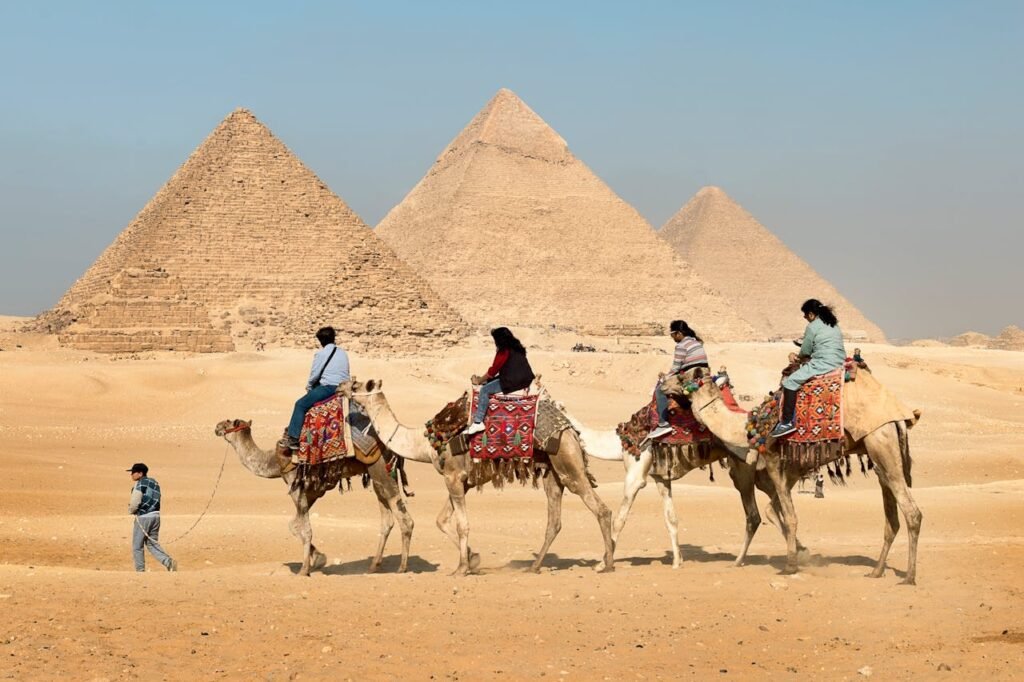

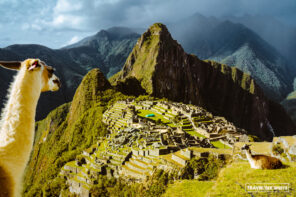

Wow- thank you for sharing about this incredible journey! I love the idea of slowing down and enjoying every minute (and every mile) of the journey. I would love to walk these roads one day. I can only imagine how beautiful it must have been. Your photos are wonderful, and I really enjoyed reading about your experience.
What an amazing route, it looks so beautiful. I would never think to take a trip like this, but it seems like you had an amazing time filled with great food. The gelato looked so yummy! Can’t wait to visit Italy someday.
What a wonderful pilgrimage! I so want to do this and to walk through wine country is even more appealing. what a cute picnic lunch by your trek guide….. his apron cracked me up and it at a church?? everything sounds so rustic, away from the hustle and bustle of the city. Its no onwder you enjoyed it so much.
Archana I so appreciate the blessing of slow travel. Life is meant to be sipped and enjoyed; not gulped too quickly. So happy to see you took time and savored this trip, this time around. What an eye-popping place!
Oh I so want to do this. The countryside, the wine, the food and the history. This is my idea of enjoying the delights of Italy. Thanks for all the information.
Loved reading this. I walked the Camino Frances two years ago and have been itching to do another long walk ever since. I hadn’t considered the Via Francigena Toscana trail, but Italian food, countryside and I love the look of medieval Manhattan is making me think this could be the next one. Thanks for the inspiration.
What an incredible walk! We’re on the other side and further north of Italy, but I love to return to Tuscany. It sounds as though you had a spiritual trip almost, after bonding with the group and being surrounded by stunning nature. I’d love to follow this route, Siena is always beautiful!
Can’t believe I never heard of this beautiful place before in so many blogs about italy. I must say the bmw owner had a wicked sense of humor 🙂
Loved reading about this old pilgrimage and loved the pictures. This is really great.
You just gave me a great idea for an itinerary in Italy. I love slow travel and I had no idea about Via Francigena Toscana. There are many pilgrimage places in Europe that I would love to see.
Great itinerary and tips! Tuscany is one of my ultimate dream destinations. I’m sure it’s a place for slow travel. I wouldn’t want to rush. I would like to experience each thing bit by bit. 🙂
One of the incredible walk I’ve ever read. Long, but the views, the food, and the people you met along the way are just amazing. What I meant by the people, it’s not only the locals, but mostly the ones in your group. It must be one of your highlight of the year.
Good post. Your findings are good.
Very helpful information. You just gave me a great idea for an itinerary in Italy.
Your trip sounds totally amazing. I would love to go your steps though Tuscany and discover the wineries around. The way sounds so peaceful and calm, I am sure it’s relaxing experience to switch off from the routine and forget about the world.
I love that you say that the Tuscan countryside is meant to be savoured rather than gulped as this really chimes with how I like to travel. Of course, like you, we will tick off many of the key sites on a first visit, but we love to slow down and really feel a place too. The Via Francigena looks ideal for that, a beautiful way to explore the region. Thanks for giving us an insight into what it was like along the way!
A friend of mine did this walk a few years ago. She also had an extremely positive experience. This is such an incredible way to see the heart of the country. I love your photos and descriptions! Slow travel for the win.
Via Francigena Toscana looks like a trail for serious walkers and a great way to see the country. The balance of historic sites, nature and food and wine experiences makes it really attractive. But I’m not sure I could handle 6 days!
This is such a beautiful article with so many great impressions. I have been last summer to Tuscany, but only by car and still, I was completely amazed by that wonderful piece of landscape. To be honest, I never even thought about making a walk along the Via Francigena but now after reading your article, I am seriously considering this as an option for next summer. Italy is so to say just around the corner and I really like the idea of re-visiting places to discover them new.
I’m British and I have totally forgotten about the pilgrim path to Rome! I am now going to research this a bit more as this would be something I would love to do (walk or cycle..who knows). I love reading about your experience and seeing your impressions of the places. I love Tuscany, it’s one of my favourite areas in Italy and I can’t wait to go back.
It is amazing how your slow travel can add so many details to the same place. I loved reading through your entire journey and honestly, am a tad bit envious of you. I would want to do this myself. Among all the places you visited, the one that intrigued me the most was ‘Medieval Manhattan with its 14 towers. I sure want to know more!
This is breathtaking! The view is just so beautiful. I wish we had visited Italy during our honeymoon.
Thank you for sharing about your trip. Did not realize there’s so much to see and do. Appreciate all the tips and your photos are great.
As I always see, is there any place in Italy that’s not gorgeous??? The Tuscan countryside is just so serene and peaceful, isn’t it? Walking across it is just awesome.
San Gimignano looks spectacular. To know that these sites have been functional since 2000yrs is mind-blowing.
Wow… terrific trail. I think I saw it in some movie a few years ago. Magnificent expanses!
I have been to Rome but not here. it looks so beautiful. I would love to take this route.